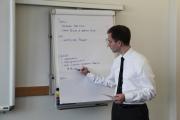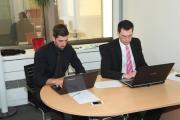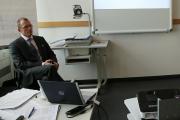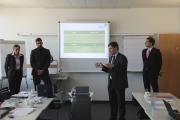Entrepreneurship – a topic defined as a challenge, desire, inevitable or simply necessary for our economy. Missing adjectives to the theme here were addressed by Lecturer Mark Henny LLM MBA at the beginning of the lecture in an open round, what the ZEBS students define as entrepreneurship and how they have experienced entrepreneurship so far in their careers. The Lecturer`s first experience of entrepreneurship was with a well-known international bank. After his corporate career, Mr. Henny began with his own investment fund and thus experienced entrepreneurship loosened from the corporate framework. The best prerequisites to fill and lead a course on this topic.
The course’s kick-off addressed academia’s definition of entrepreneurial traits and the situation of entrepreneurial opportunities. The nature of entrepreneurship was examined and discussed with the perspectives on structural thinking, engaging in bricolage, affective and cognitive adaption. The latter was progressed with academia’s recommendation in how this can be further developed by an entrepreneur asking him/herself comprehension questions, setting connection and strategic tasks.
Special emphasis was given on the way entrepreneurs think and how this form of thinking can be fostered. Emphasis was also put on failures and the chances which these give for learning to people who want to be entrepreneurs. We all know the two polarizations of dealing with failure; how good it can be for a mindset to ignore them and how rich in learning it may be to analyze failure.
Motivations and background information about why individuals act in an entrepreneurial manner, were discussed from an academic`s perspective and the class view on this question. The importance of role models along with the various networking aspects for an entrepreneur were highlighted.
In the zeitgeist of sustainability the impact on economy was addressed with regard to new products, processes and services which finally lead to economic, environmental and social gains.
After working on general aspects of entrepreneurship and its research done by academia so far, it was analyzed in the context of corporations. Motivations to become entrepreneurial in a corporate environment, differences on the management styles of both administrative and entrepreneurial firms and the comparison of different aspects of the decision making process were parts of the course content. The following steps were dealt with; establishing entrepreneurship within a company, the formal necessities such as building a coalition, connecting all management levels, eroding the financial resources for this undertaking and making sure that there are supporters. Finally, academia’s reasoning why undertakings in the corporate environment most probably result in a less successful story or at least, less profitable, was set into comparison with new entry entrepreneurships.
After the corporate, the new entry entrepreneurships were examined in this lecture. What makes a new entry worth performing, is it the product, strategy or the organization? The group discussed academia’s structural approach to generating new entry models and the necessities of these. How could resources be applied in creating valuable, rare and inimitable products and services? What are the factors that influence the decision to enter a market immediately or later? The perspectives of first mover advantages and disadvantages were vastly eroded. Strategies of managing uncertainties in risk, technology, scope and demand where analyzed and discussed and of course the downside from the customer`s perspective was taken into account when working on the new entrant`s topic. The focus on new and imitated products for new entrants closed this part on entrepreneurship.
Mark Henny moved the course’s content over to the topic of business plans, probably the most crucial asset in an entrepreneurial offset – one should think. This was cooled down with the current perspective and experiences on these - especially from venture capitalists. The context of POCD and a business plan fitting in to it was processed. Do the people fit for what it takes to realize the idea; are there opportunities which are a must to be captured? Is there an obstacle to capturing the market? What about the context, is there anything that could make the business model unsuited to the current surrounding? And finally, what does the deal look like, especially for those funding the plan? How should financial projections be dealt with and what are the actual problems with these when working on a business model? This rounded off the session on the business plan perspective.
Special attention was given to the opportunities for how an entrepreneurial idea can be protected. Intellectual property and the best way to deal with it was one side of this discussion, patents, creating them and minimizing patent risks was another. Trademarks, copyrights and an analysis of trade secrets and non-competition agreements rounded this chapter of the session off.
Mark Henny and the students used throughout the course, a number of case studies which served to nourish the discussions and perceptions alongside the students` own ideas.
All in all, entrepreneurship remains an exciting topic. The ZEBS students still consider entrepreneurship as a desirable goal. Some are already entrepreneurs. Mark Henny managed to prepare the group with more technical knowledge and useful tools to support the individuals’ entrepreneurial undertakings.
Peter – IMP student










